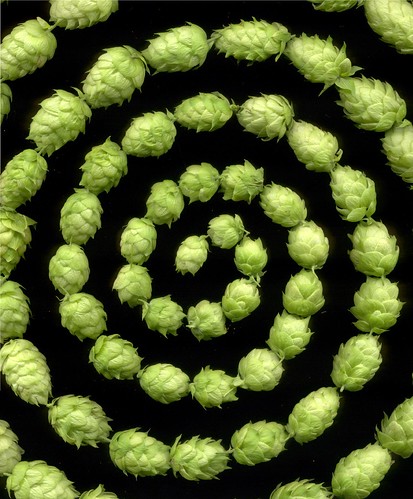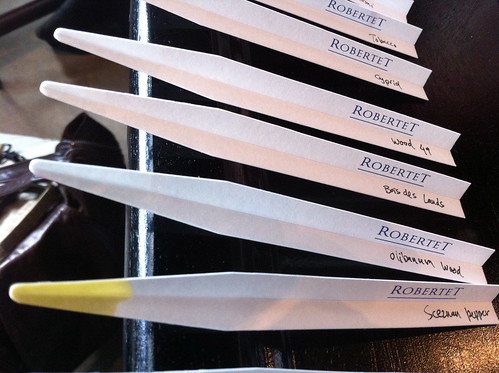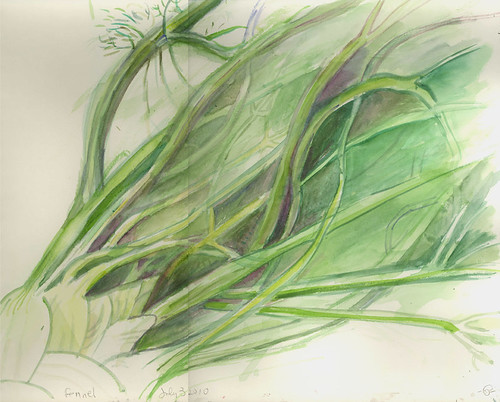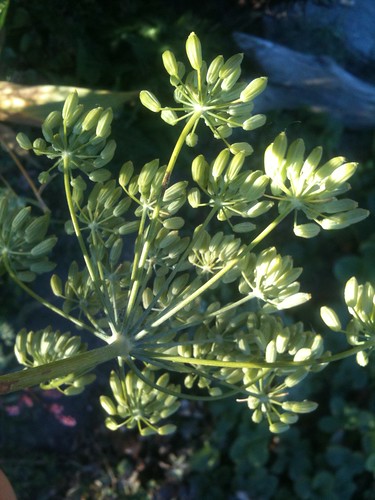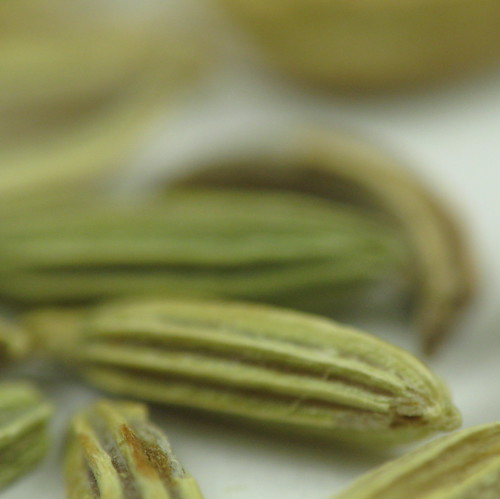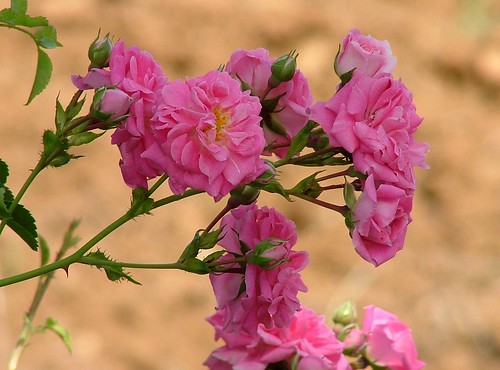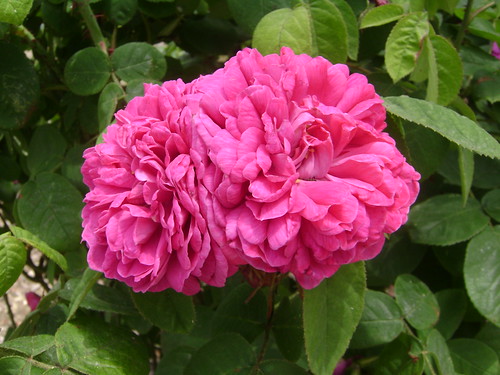Humulus Lupulus (Hops)
Hops (Humulus lupulus) is a climbing perennial herb, with separate female and male plants. It is the female flowers that are valued for their aroma and flavour in the production of beer. Glandular hairs in the strobile-shaped female flowers store lupulin, a molecule that accounts for hops’ distinctive fresh-fruity aroma and bitter flavour. It also contains humulone, isohumulone and humulene which are bitter-tasting compounds. It also contains the natural phenols xanthohumol, isoxanthohumol and the most estrogenic phytoestrogen known, 8-prenylnaringenin. Hops’ natural oils help the yeast grow by eliminating other microbs and cultures and thus prevent spoilage.
It is native to Europe and North America, and is mostly cultivated in Germany, Yugoslavia, and in California and Washington states. Hops oil is produced in the UK, Germany and France. An Absolute and CO2 extraction is also possible, the latter becoming increasingly popular as it brings a more complete profile of the fresh plant.
In herbal medicine, hops is valued for its relaxing effects, and was used by herbalists to treat insomnia, nervous tension, neuralgia and sexual neurosis. It helps women’s oestrogens, and was used for heavy periods. Hops-stuffed pillows were used to induce sleep as it is a mild sedative, similar to valerian's but milder. The aromatics in the pillow get released by resting the head upon it and crushing the strobiles. Chinese medicine used hops for pumonary tuberculosis and cystitis. Hops is an aphrodisiac, antimicrobial, antiseptic, ansitpasmodic, astringent, bactericidal, carminative, diuretic, emollient, has oestrogenic properties, hypnotic, nervine, sedative, soporific. While hops are used in aromatherapy for dermatitis, rashes and rough skin - it’s important to note that in some individuals, skin rashes occur on their hands after picking the strobiles. Other uses are indigestion, menstrual cramps, reduces sexual overactivity and sexually related anxiety, headaches, insomnia, stress-related symptoms. (according to Julia Lawless, The Encyclopedia of Essential Oils, p. 108).
In Germany, they also use a special technique where they distill the hops with sodium chloride in the distillation water, to better separate the oil from the water; and than run a benzene (or other solvent) extraction of the distillation water to bring out the water-soluble aroma components. The “Complete” hops essence resulting from this is more true to the fresh plant and brings a better flavour and aroma - but only for a short time, as it does not keep nearly as well. Considering that fact that hops oil is extremely sensitive to light and oxigen, and spoils pretty fast anyway - this probably means the German are using it right away for beer production.
Hops oil is a greensh-yellow to reddish-brown mobile liquid (when fresh and hasn't resinified). The principal constituents in hops oil are: dipentene, myrcene, linalool, humulene, free formic acid, heptylic acid, valeric acid, esterified formic acid, acetic acid, decyclic acid, nonylic acid, octylic acid, oenanthylic acid, butyric acid and probably iso-nonylic acids (W.A. Poucher, Perfumes, Cosmetics And Soaps Vol. I, 1959, p. 209).
Fresh hops oil (which is something I probably never smelled, because even when mine was fresh, it smelled more than a tad “funky”) should be “rich, spicy-aromatic, sweet and heavy, but overall pleasant” (Arctander, Perfume and Flavors Materials of Natural Origin, p. 298). Upon oxidation, it develops valeric, isovaleric and caprylic acids, which changes the aroma to a rather unpleasant valerian-like funkym stinky-sock/locker odour. In other words: not boring, but not really pleasant either. A tell-tale sign that your hops has oxidized is if it’s no longer mobile: oxidation tends to resinify this oil.
Using hops in beer brewing did not become popular until the Middle Ages. Until then, most “beers” were in fact ales (aka un-hopped brews, cloyingly sweet and malty), and in Britain they used a combination of herbs called “gruit” which included sweet gale, sage, yarrow, pine, wormwood and broom.
While most of the production of hops goes directly into the thriving beer industry, it does find some use in some spice blends and sauces (I’m still looking for recipes for you!), flavouring tobacco, and for flavouring liquors (usually in combination with oils of angelica root, cascarilla and the like - in short: musky, bitter, herbaceous oils). What little hops makes it to the perfume industry like ends up in colognes (where it will add an unusual fruity note to complement the citrus and herbs), fougeres, and perhaps some oriental bases, where its spiciness will shine if treated well.
It is native to Europe and North America, and is mostly cultivated in Germany, Yugoslavia, and in California and Washington states. Hops oil is produced in the UK, Germany and France. An Absolute and CO2 extraction is also possible, the latter becoming increasingly popular as it brings a more complete profile of the fresh plant.
In herbal medicine, hops is valued for its relaxing effects, and was used by herbalists to treat insomnia, nervous tension, neuralgia and sexual neurosis. It helps women’s oestrogens, and was used for heavy periods. Hops-stuffed pillows were used to induce sleep as it is a mild sedative, similar to valerian's but milder. The aromatics in the pillow get released by resting the head upon it and crushing the strobiles. Chinese medicine used hops for pumonary tuberculosis and cystitis. Hops is an aphrodisiac, antimicrobial, antiseptic, ansitpasmodic, astringent, bactericidal, carminative, diuretic, emollient, has oestrogenic properties, hypnotic, nervine, sedative, soporific. While hops are used in aromatherapy for dermatitis, rashes and rough skin - it’s important to note that in some individuals, skin rashes occur on their hands after picking the strobiles. Other uses are indigestion, menstrual cramps, reduces sexual overactivity and sexually related anxiety, headaches, insomnia, stress-related symptoms. (according to Julia Lawless, The Encyclopedia of Essential Oils, p. 108).
In Germany, they also use a special technique where they distill the hops with sodium chloride in the distillation water, to better separate the oil from the water; and than run a benzene (or other solvent) extraction of the distillation water to bring out the water-soluble aroma components. The “Complete” hops essence resulting from this is more true to the fresh plant and brings a better flavour and aroma - but only for a short time, as it does not keep nearly as well. Considering that fact that hops oil is extremely sensitive to light and oxigen, and spoils pretty fast anyway - this probably means the German are using it right away for beer production.
Hops oil is a greensh-yellow to reddish-brown mobile liquid (when fresh and hasn't resinified). The principal constituents in hops oil are: dipentene, myrcene, linalool, humulene, free formic acid, heptylic acid, valeric acid, esterified formic acid, acetic acid, decyclic acid, nonylic acid, octylic acid, oenanthylic acid, butyric acid and probably iso-nonylic acids (W.A. Poucher, Perfumes, Cosmetics And Soaps Vol. I, 1959, p. 209).
Fresh hops oil (which is something I probably never smelled, because even when mine was fresh, it smelled more than a tad “funky”) should be “rich, spicy-aromatic, sweet and heavy, but overall pleasant” (Arctander, Perfume and Flavors Materials of Natural Origin, p. 298). Upon oxidation, it develops valeric, isovaleric and caprylic acids, which changes the aroma to a rather unpleasant valerian-like funkym stinky-sock/locker odour. In other words: not boring, but not really pleasant either. A tell-tale sign that your hops has oxidized is if it’s no longer mobile: oxidation tends to resinify this oil.
Using hops in beer brewing did not become popular until the Middle Ages. Until then, most “beers” were in fact ales (aka un-hopped brews, cloyingly sweet and malty), and in Britain they used a combination of herbs called “gruit” which included sweet gale, sage, yarrow, pine, wormwood and broom.
While most of the production of hops goes directly into the thriving beer industry, it does find some use in some spice blends and sauces (I’m still looking for recipes for you!), flavouring tobacco, and for flavouring liquors (usually in combination with oils of angelica root, cascarilla and the like - in short: musky, bitter, herbaceous oils). What little hops makes it to the perfume industry like ends up in colognes (where it will add an unusual fruity note to complement the citrus and herbs), fougeres, and perhaps some oriental bases, where its spiciness will shine if treated well.


